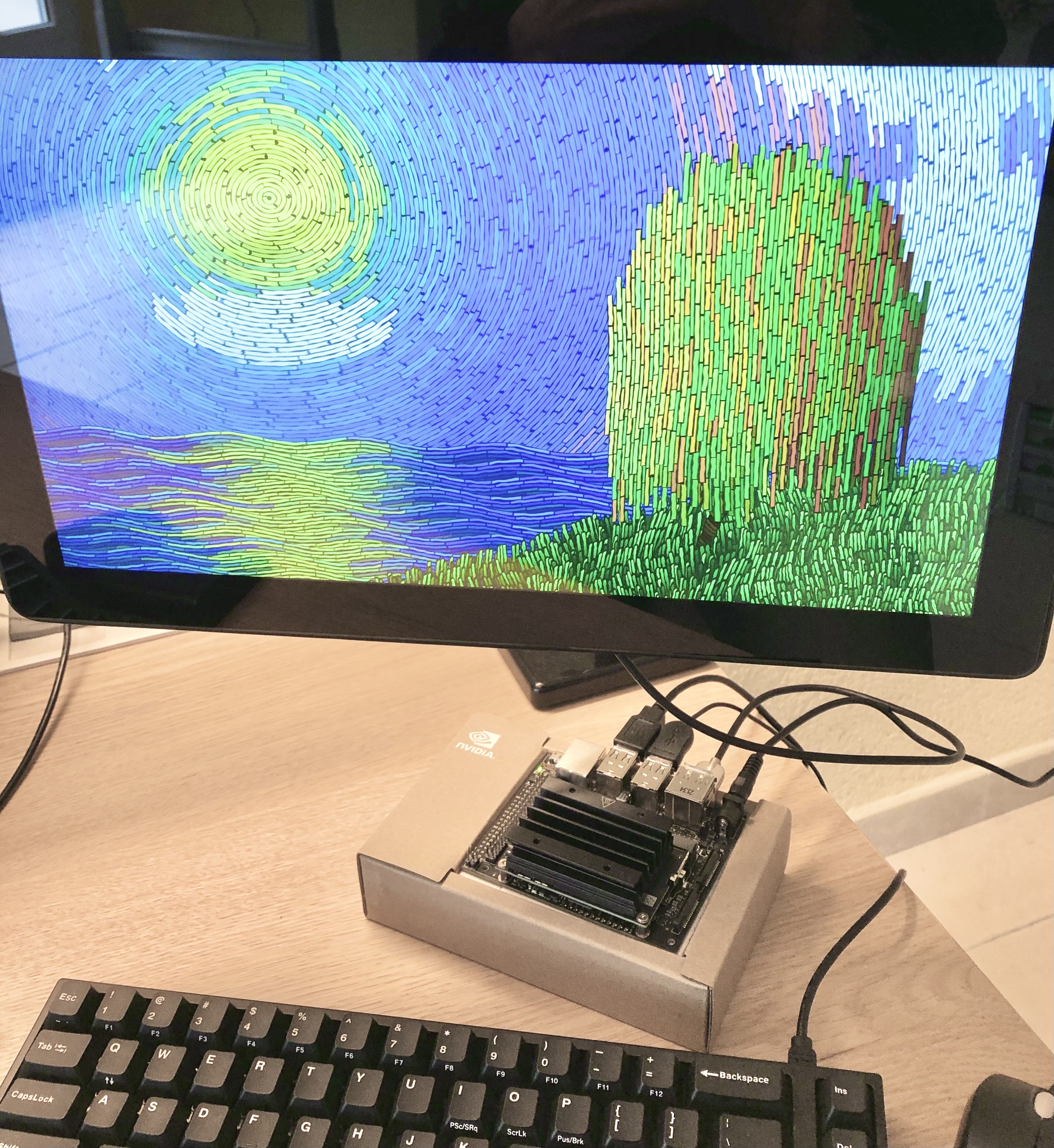KMS GLSL is a command line tool that runs OpenGL fragment shaders, using the DRM/KMS Linux kernel subsystem. It runs shaders fullscreen, and does not require any windowing system, like X or Wayland.
It has initially been developed to run shaders from Shadertoy, on the Raspberry Pi. However, it works with any GPU and display controller hardware, provided a DRM/KMS driver is available, like on the Jetson Nano. Examples of configuration, where it's been reported to run successfully on, are listed in the compatibility section.
In the following picture, this Shadertoy shader runs on the Raspberry Pi 4, connected to the official Raspberry Pi 7" touchscreen monitor, in WVGA resolution:
Another shader that runs on the Jetson Nano in full HD resolution:
You need to clone the project, and run the following commands:
$ sudo apt update
# Install the build tools
$ sudo apt install gcc make
# Install the required DRM, GBM, EGL and OpenGL ES API headers
$ sudo apt install libdrm-dev libgbm-dev libegl-dev libgles2-mesa-dev
# Install the X C binding and RandR extension header / library files (optional)
$ sudo apt install libxcb-randr0-dev
# Build the glsl binary and library
$ makeOnce you've successfully built the binary / library, you can either run it directly, or use the Python wrapper, that adds a layer for managing shader inputs, that you can also extend to add your own custom inputs.
$ ./glsl -h
Usage: ./glsl [-aACDfmnpvx] <shader_file>
options:
-a, --async use async page flipping
-A, --atomic use atomic mode setting and fencing
-C, --connector=ID use the connector with the provided ID (see drm_info)
-D, --device=DEVICE use the given device
-f, --format=FOURCC framebuffer format
-h, --help print usage
-m, --modifier=MODIFIER hardcode the selected modifier
-n, --frames=N run for the given number of frames and exit
-p, --perfcntr=LIST sample specified performance counters using
the AMD_performance_monitor extension (comma
separated list)
-v, --vmode=VMODE specify the video mode in the format
<mode>[-<vrefresh>]
-x, --surfaceless use surfaceless mode, instead of GBM surfaceYou can try it with the shaders available in the examples directory, e.g.:
$ ./glsl examples/costal_landscape.glslPress Ctrl+c to exit the program.
You can explore shadertoy.com to find additional shaders.
Note the shaders from the examples directory assume OpenGL ES 3.1 support, and may not work with lower versions of the specification.
No inputs can be provided using the native CLI directly. You can use the Python wrapper, that adds a layer around the native library for managing shader inputs, as explained below.
$ python glsl.py -h
usage: glsl.py [-h] [--async-page-flip | --no-async-page-flip]
[--atomic-drm-mode | --no-atomic-drm-mode] [-C CONNECTOR]
[-D DEVICE] [--mode MODE] [-n N] [-k UNIFORM]
[--touchscreen UNIFORM] [--trackpad UNIFORM] [-c UNIFORM FILE]
[-t UNIFORM FILE] [-v UNIFORM FILE] [-m <UNIFORM>.KEY VALUE]
FILE
Run OpenGL shaders using DRM/KMS
positional arguments:
FILE the shader file
options:
-h, --help show this help message and exit
--async-page-flip, --no-async-page-flip
use async page flipping
--atomic-drm-mode, --no-atomic-drm-mode
use atomic mode setting and fencing
-C CONNECTOR, --connector CONNECTOR
the DRM connector
-D DEVICE, --device DEVICE
the DRM device
--mode MODE specify the video mode in the format
<resolution>[-<vrefresh>]
-n N, --frames N run for the given number of frames and exit
-k UNIFORM, --keyboard UNIFORM
add keyboard
--touchscreen UNIFORM
add touchscreen device
--trackpad UNIFORM add trackpad device
-c UNIFORM FILE, --cubemap UNIFORM FILE
add cubemap
-t UNIFORM FILE, --texture UNIFORM FILE
add texture
-v UNIFORM FILE, --volume UNIFORM FILE
add volume
-m <UNIFORM>.KEY VALUE, --metadata <UNIFORM>.KEY VALUE
set uniform metadataNote
Python 3.10+ is required.
You'll have to install the required dependencies once, e.g., with venv:
$ python -m venv .venv
$ source .venv/bin/activate
$ pip install libevdev pillowYou may also want to be in the input group, so /dev/input/eventX devices can be open to handle evdev events, without running as root, e.g.:
$ sudo adduser $USER inputYou can then try it with the shaders available in the examples directory, e.g.:
$ python glsl.py examples/plasma_globe.glsl -t iChannel0 presets/tex_RGBA_noise_medium.pngPress Ctrl+c to exit the program. You can explore shadertoy.com to find additional shaders.
If you want to add your own inputs, you can find the documentation and some examples in the glsl.py file.
It's been reported to run successfully on the following configurations:
| Hardware | OS / Kernel | Driver | Date |
|---|---|---|---|
| NVIDIA GeForce RTX 3060 | Ubuntu 23.10, Linux 6.5 | NVIDIA Driver 545.29.06 | 03/2024 |
| Jetson Orin NX | Jetson Linux 35.3.1, Linux 5.10 | NVIDIA DRM Driver | 09/2023 |
| Jetson Nano (Tegra X1) | Jetson Linux 32.7.4, Linux 4.6 | Mesa NVIDIA Tegra | 06/2023 |
| Raspberry Pi 4 (Broadcom VideoCore VI) | Raspberry Pi OS 2023-02, Linux 5.15 | Mesa VC4 V3D 19.3.2 | 09/2023 |
| Raspberry Pi Zero W (Broadcom VideoCore IV) | Raspberry Pi OS 2022-09, Linux 5.15 | Mesa VC4 V3D 19.3.2 | 05/2023 |
| Raspberry Pi 3B+ (Broadcom VideoCore IV) | Raspberry Pi OS Lite 2020-12, Linux 5.4.79 | Mesa VC4 V3D 19.3.2 | 08/2021 |
- Add support for texture buffers
- Add support for audio / video inputs
- Parse GLSL files to retrieve uniforms metadata
The DRM/KMS ceremony code is copied from kmscube.
The shader examples are copied from the Shadertoy website URLs commented at the top of each file.

